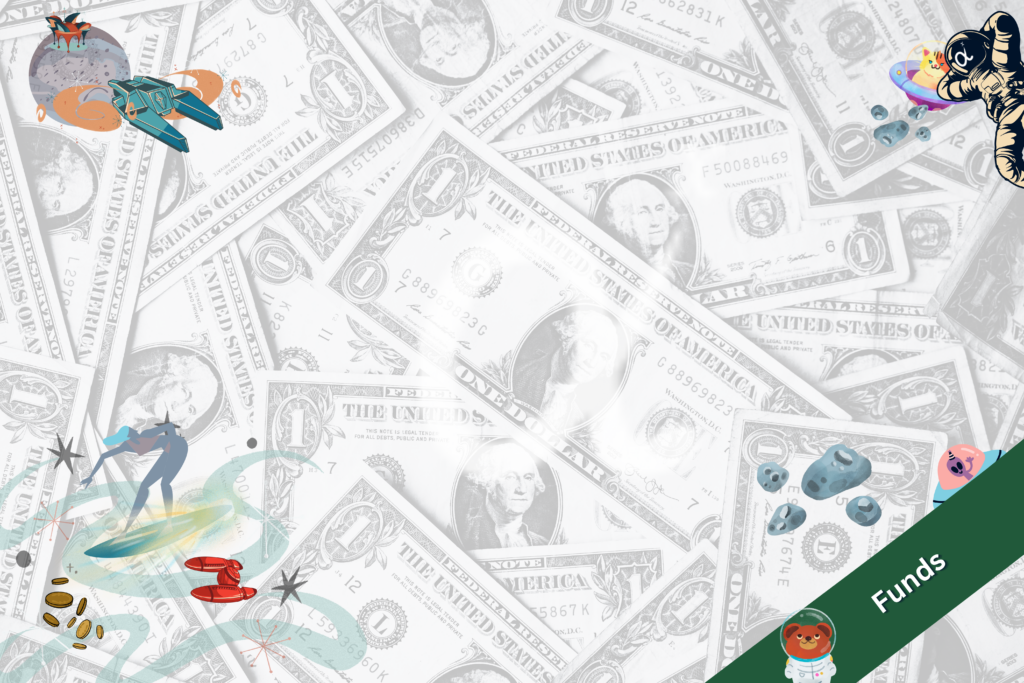The second triangle: the Descending Triangle
Read MoreFunds: How to read fact sheets
What should you look at when investing in funds?

Before this, we’ve talked about the difference between a fund’s fact sheet and prospectus. In this article and the next one, we will move deeper into each of the two. Now, let’s see what you need to know from a fund’s fact sheet before you can get investing.
What is a fact sheet?
A Fact Sheet is like a quick cheat sheet or a “SparkNotes” for a mutual fund. It’s a handy one-page document that gives you a sneak peek into what a mutual fund is all about without having to read a whole book of details. If you’re ever on dating apps, this is like the first page where you’ll have to decide to either swipe left or right.
What do you want to see in a fact sheet?

In this article, we’ll take a look at BlackRock’s iShares S&P 500 Growth ETF (it’s an ETF, but the fact sheet works the same for the two) as an example. Mind you, a fact sheet may have more than what we are to mention now, or it may have less, but all the things mentioned below are the essentials of a fund’s fact sheet.
The Fund’s Name and Ticker
Well… this is quite obvious, but a fund’s name is an important part of its fact sheet. In this case, the fund that we chose as an example is BlackRock’s iShares S&P 500 Growth ETF. The ticker (which is the fancy way of saying ‘codename’ or what) is IVW. So, if you Google “IVW” or “Ticker IVW”, you’ll get to this fund.
A fund’s name also gives you an insight into the general nature of the fund. From this fund’s name, we can somewhat guess that this fund invests in the S&P 500 and invests in companies that provide gains from shares’ growth and not income like dividends, etc.
What it’s trying to do
Every fund has a certain goal and methods to achieve that goal. As an investor in funds, you don’t have to be good at stock picking, but you must know the basics of investment so that you can choose a fund that you think has a goal that suits you, and the strategy is plausible.
From the above, you can tell that the fund’s goal is to track an index’s performance (Yellow), so if you’re into performing as well (or as badly) as the market is currently doing, then this is the fund for you.
You can also tell the strategy is to invest in large-cap US equities that grow better than average relative to the rest of the market.
How Well It’s Doing:
Fund management companies are bound to disclose their performance to the customers. From the picture above, we can see that there are two kinds of performance that BlackRock exhibits:
- What if you invested $10,000 when the fund was created?
- How does the fund perform over the course of a certain period compared to the benchmark?
The “what if you invested $10,000” is quite obvious, they just want to give you a visualization of how your money would grow if you’d invested in that fund earlier on.
The next one is what’s important. You get to see how the fund performs in terms of its Net Asset Value (NAV), Market Price, and how the benchmark is doing.
Question: Why do they need a benchmark? Why not just see how the fund has performed since the day it was established?
Answer: many funds would usually go up in value, but that’s not the mark of a good fund. You’re literally paying these people to manage your money. You don’t want it to perform lower than the market. Like, show your skills, we paid you not to be worse than the market!
If you look above, they have 5 main periods.
1 Year: How the fund and the benchmark perform in 1 year.
3 Years: How the fund and the benchmark perform in 3 years.
5 Years: How the fund and the benchmark perform in 5 years.
10 Years: How the fund and the benchmark perform in 10 years.
Since inception: How the fund and the benchmark perform since the day the fund was created.
So, from the above, you can say, for example, that this fund has performed lower than the benchmark since the fund’s inception.
How Much It Costs
Surprises are nice, but not when you have to suddenly pay for something. Funds are required to disclose the fees that they charge you. The NAV would change from time to time, but a fund’s fee would usually stay the same. This can also help you compare which fund is a better bargain.
What you want to do is calculate how much your money can grow, having factored in their fees and performance relative to the benchmark — although keep in mind that past performance doesn’t always mean that it’s going to perform well in the future, it gives a good light on the fund manager’s ability to manage the fund.
What’s Inside
A fund would usually disclose the assets that it holds. This can somewhat tell you how the fund might perform. For example, if you think that Stock ABC is overhyped and shouldn’t be on the list, but it constitutes a huge proportion of the fund, then you can say no to the fund right away.
Risk & Other Things
The risk is measured in terms of volatility, like how volatile is the fund relative to the benchmark. Risk is usually measured in Beta. Per the above, we can see that the fund is slightly more volatile than the benchmark (S&P 500). A Beta value of 1.13 usually means that if the benchmark moves by 1 step (up or down), the fund will usually move 1.13 steps along it.
For a fund that tracks an index, it would be normal for the Beta to be closer to 1, while for the ones that seek to outpace the benchmark, the Beta would normally be a bit higher, around 1.5 or higher.
You can also look into its volatility through the Standard Deviation. There is also other information such as the Price-to-earnings (P/E) ratio and the Price to Book ratio (P/B). Some funds also have a dedicated fund manager (usually if they’re well-known investors) that will manage the fund, and their names would be mentioned too.
In essence, the Fact Sheet is your quick and user-friendly guide to a mutual fund. It’s like watching a trailer before deciding whether you want to see the whole movie. But remember, while it gives you a great overview, it doesn’t replace the need to dig deeper.
The Prospectus: The Deep Dive into Fund Details

Now, let’s move on to Prospectus, often described as the mutual fund’s “owner’s manual.” If the Fact Sheet is the trailer, the Prospectus is the entire movie, complete with all the details and fine print.
1. Comprehensive Information
A Prospectus is a comprehensive document that covers every aspect of the mutual fund in detail. It’s legally required and provides you with a complete understanding of what you’re investing in. Think of it as an encyclopedia for the fund.
2. Regulatory Requirements
Mutual funds are legally obligated to provide a Prospectus to potential investors. This document complies with regulatory standards and includes all the legal disclosures necessary to protect investors.
3. In-Depth Details
While the Fact Sheet offers a summary of performance, the Prospectus provides a deep dive into the fund’s investment strategies, historical performance, fee structures, and redemption policies. It’s where you find the director’s cut with all the extended scenes and behind-the-scenes action.
4. Risk Factors
If you want to know the potential plot twists in your investment journey, the Prospectus outlines all the risks associated with the fund. It’s the equivalent of reading the book before seeing the movie, ensuring you’re prepared for any surprises.
5. Legal Information
The Prospectus also includes legal information, such as how to buy and sell fund shares, how taxes are handled, and any other terms and conditions. It’s like the terms of service you agree to when signing up for an online platform.
6. Historical Performance
While the Fact Sheet provides recent performance data, the Prospectus often includes a more extensive history of the fund’s performance, allowing you to see how it has performed over various market conditions.
7. Redemption Policies
If you ever want to sell your fund shares, the Prospectus outlines the process and any associated fees or restrictions. It’s your guide to the exit strategy.
Bottom line
Here’s what you need to look for in a Fact Sheet:
- Fund’s Name and Symbol: This tells you what the fund is called and how to find it, like a book title.
- What It Does: This explains what the fund aims to achieve, similar to understanding a story’s plot.
- How Well It’s Doing: Check its recent performance to see if it’s been doing well, like reading reviews for a movie.
- How Much It Costs: Look at the fees to know how much you’ll pay, like checking the price of a product.
- What’s Inside: See what the fund is investing in, like checking ingredients in a recipe.
- Risks and Other Info: Learn about how risky it is and find extra details like a book’s author.
In short, a Fact Sheet is your quick guide to a mutual fund. It helps you decide if you want to invest in it or choose something else. Think of it as the trailer before you watch the whole movie!
The key takeaways/market update is a series by AxeHedge, which serves as an initiative to bring compact and informative In/Visible Talks recaps/takeaways on leading brands and investment events happening around the globe.
Do keep an eye out for our posts by subscribing to our channel and social media.
None of the material above or on our website is to be construed as a solicitation, recommendation or offer to buy or sell any security, financial product or instrument. Investors should carefully consider if the security and/or product is suitable for them in view of their entire investment portfolio. All investing involves risks, including the possible loss of money invested, and past performance does not guarantee future performance.
Trading Dow Pattern the Triangle Pattern (Part 1)
The first triangle: the Ascending Triangle
Read MoreFunds: Equity Funds (Part 3)
How to choose between equity funds based on companies’ earnings...
Read More



